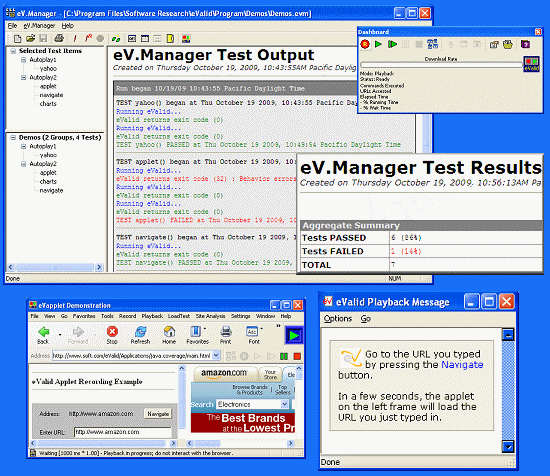Functional Test Base Development
During development of
eValid
Functional Tests, eValid prompts you
to define a test Project and, within that Project, a set of
Test Groups.
The Project, Group, and Test name are then made a permanent
part of the eValid test script.
This structure makes it possible to store test scripts,
and associated test results,
for many hundreds or thousands of tests in each Project.
eValid and eV.Manager impose limits on the number of tests
in a test Group, or on the number of Groups in a Project.
Test Suite Tree Construction
Construction of the test suite from the set of functional tests
is automatic.
Tests in the Project folder, arranged into test Groups, are reflected
in a hierarchical tree structure.
You can add/delete/modify tests at any time and automatically
re-constitute the complete test tree.
The Project/Group/Test structure is the same structure one used
by eValid during test creation process.
Test Execution Selection
Once the test tree is known to eV.Manager you may select
any test, any Group of tests, or an entire Project.
Once selected for execution you can then remove any single
test or Group of tests.
After you have final-selected the tests to be run
you click one "GO" button to run the selected test suite.
Automated Execution Process
Once begun, eV.Manager records details from each test execution
including start and stop time, test exit code and error message (if any).
Tests run via batch command invocations to eValid and you can
see eValid running the tests in real time on the screen as eV.Manager runs each one in turn.
All tests run to normal completion,
subject to all current eValid preferences
and possibly modified by PlayValue settings within each script,
or to an Error status.
Each test outcome yields a PASS or a FAIL status.
The PASS/FAIL status is shown
in the test log and the eV.Manager's test summary reports.
Regression Test Report
At the end of a test, eV.Manager accumulates the PASS and FAIL status
and presents a regression testing summary that gives
the total number of tests,
the total number of PASSed tests,
and
the total number of FAILed tests.
Bonus LoadTest, Site Analysis Applications
As a bonus application, eValid regression tests can form the basis of a
LoadTest Server Loading scenario.
In most cases you can select a subset of the tests in the regression test tree
and use the
LoadTest Scenario Editor to compose a realistic set of
user simulations that are indistinguishable by your server from real users.
And, you can generate large quantities of non-coherent
website traffic using the built-in
Site Analysis engine.
Sample Screen
Below is a sample that shows eV.Manager running a suite of tests by
invoking eValid for the selected set of tests in the test suite.
|
|
Key Benefits
Here are a few of the main advantages of
eValid under eV.Manager control.
| | • |
Totally automated regression suite execution.
|
| • |
Able to regression test any type of user activity.
|
| • |
Functional Tests Support on-screen processing of
Applets,
file downloads,
Flash, ActiveX, XML/XSLM, Dynamic HTTP.
|
| • |
Selectable sub-tree and individual test runs.
|
| • |
Unlimited Test and Group capacity in each Project.
|
| • |
Optimized for a suite of ~1,000 tests.
|
| • |
Tests typically organized into
20-50 Groups of 20-50 Tests per group.
|
| • |
Automatic PASS/FAIL reporting for all tests.
|
| • |
Test scripts in a regression suite can be used in a server loading LoadTest scenario.
|
| • |
Full batch mode operation available.
|
|
|
